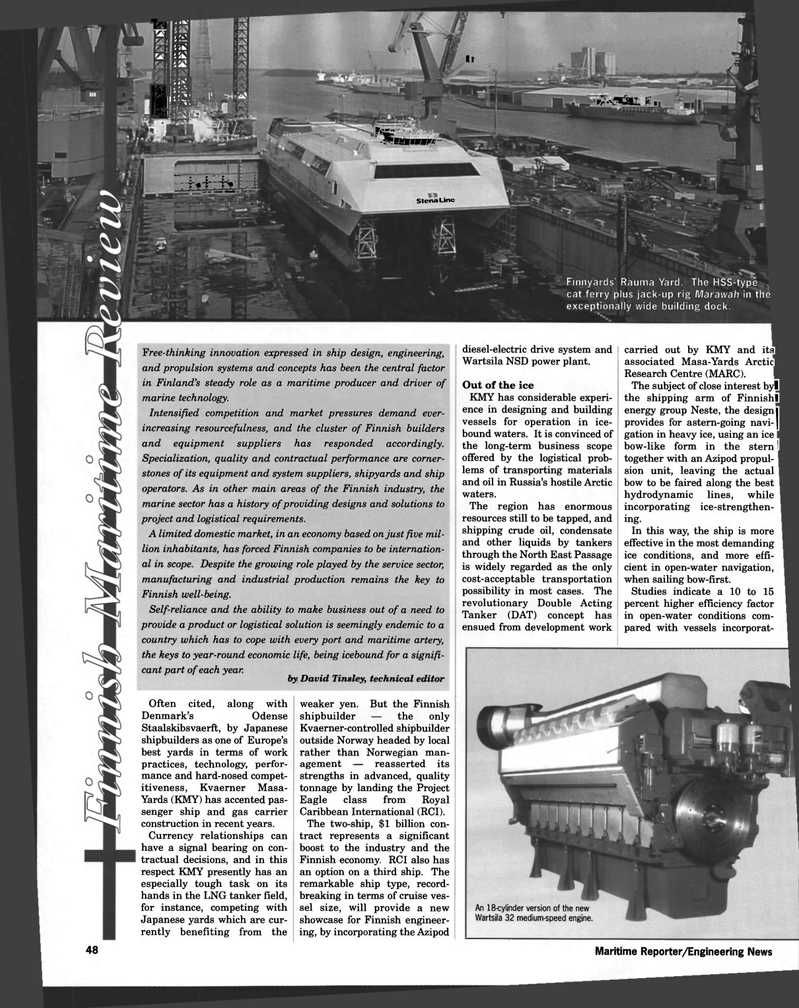
Page 48: of Maritime Reporter Magazine (August 1997)
Read this page in Pdf, Flash or Html5 edition of August 1997 Maritime Reporter Magazine
Ts . « V M} t 'vl 2
JiiJ
Mi am as
IH! k I' WTi'ia? r% rinKr ihtda ii r^BSui.i.
Storm Line
Finnyards' Rauma Yard. The HSS-type cat ferry plus jack-up rig Marawah in the exceptionally wide building dock.
Free-thinking innovation expressed in ship design, engineering, and propulsion systems and concepts has been the central factor in Finland's steady role as a maritime producer and driver of marine technology.
Intensified competition and market pressures demand ever- increasing resourcefulness, and the cluster of Finnish builders and equipment suppliers has responded accordingly.
Specialization, quality and contractual performance are corner- stones of its equipment and system suppliers, shipyards and ship operators. As in other main areas of the Finnish industry, the marine sector has a history of providing designs and solutions to project and logistical requirements.
A limited domestic market, in an economy based on just five mil- lion inhabitants, has forced Finnish companies to be internation- al in scope. Despite the growing role played by the service sector, manufacturing and industrial production remains the key to
Finnish well-being.
Self-reliance and the ability to make business out of a need to provide a product or logistical solution is seemingly endemic to a country which has to cope with every port and maritime artery, the keys to year-round economic life, being icebound for a signifi- cant part of each year. by David Tinsley, technical editor
Often cited, along with
Denmark's Odense
Staalskibsvaerft, by Japanese shipbuilders as one of Europe's best yards in terms of work practices, technology, perfor- mance and hard-nosed compet- itiveness, Kvaerner Masa-
Yards (KMY) has accented pas- senger ship and gas carrier construction in recent years.
Currency relationships can have a signal bearing on con- tractual decisions, and in this respect KMY presently has an especially tough task on its hands in the LNG tanker field, for instance, competing with
Japanese yards which are cur- rently benefiting from the weaker yen. But the Finnish shipbuilder — the only
Kvaerner-controlled shipbuilder outside Norway headed by local rather than Norwegian man- agement — reasserted its strengths in advanced, quality tonnage by landing the Project
Eagle class from Royal
Caribbean International (RCI).
The two-ship, $1 billion con- tract represents a significant boost to the industry and the
Finnish economy. RCI also has an option on a third ship. The remarkable ship type, record- breaking in terms of cruise ves- sel size, will provide a new showcase for Finnish engineer- ing, by incorporating the Azipod diesel-electric drive system and
Wartsila NSD power plant.
Out of the ice
KMY has considerable experi- ence in designing and building vessels for operation in ice- bound waters. It is convinced of the long-term business scope offered by the logistical prob- lems of transporting materials and oil in Russia's hostile Arctic waters.
The region has enormous resources still to be tapped, and shipping crude oil, condensate and other liquids by tankers through the North East Passage is widely regarded as the only cost-acceptable transportation possibility in most cases. The revolutionary Double Acting
Tanker (DAT) concept has ensued from development work carried out by KMY and its associated Masa-Yards Arctic
Research Centre (MARC).
The subject of close interest byl the shipping arm of Finnish! energy group Neste, the design] provides for astern-going navi-| gation in heavy ice, using an ice bow-like form in the stern I together with an Azipod propul- sion unit, leaving the actual bow to be faired along the best hydrodynamic lines, while incorporating ice-strengthen- ing.
In this way, the ship is more effective in the most demanding ice conditions, and more effi- cient in open-water navigation, when sailing bow-first.
Studies indicate a 10 to 15 percent higher efficiency factor in open-water conditions com- pared with vessels incorporat-
An 18-cylinder version of the new
Wartsila 32 medium-speed engine. 48 Maritime Reporter/Engineering News

 47
47

 49
49
